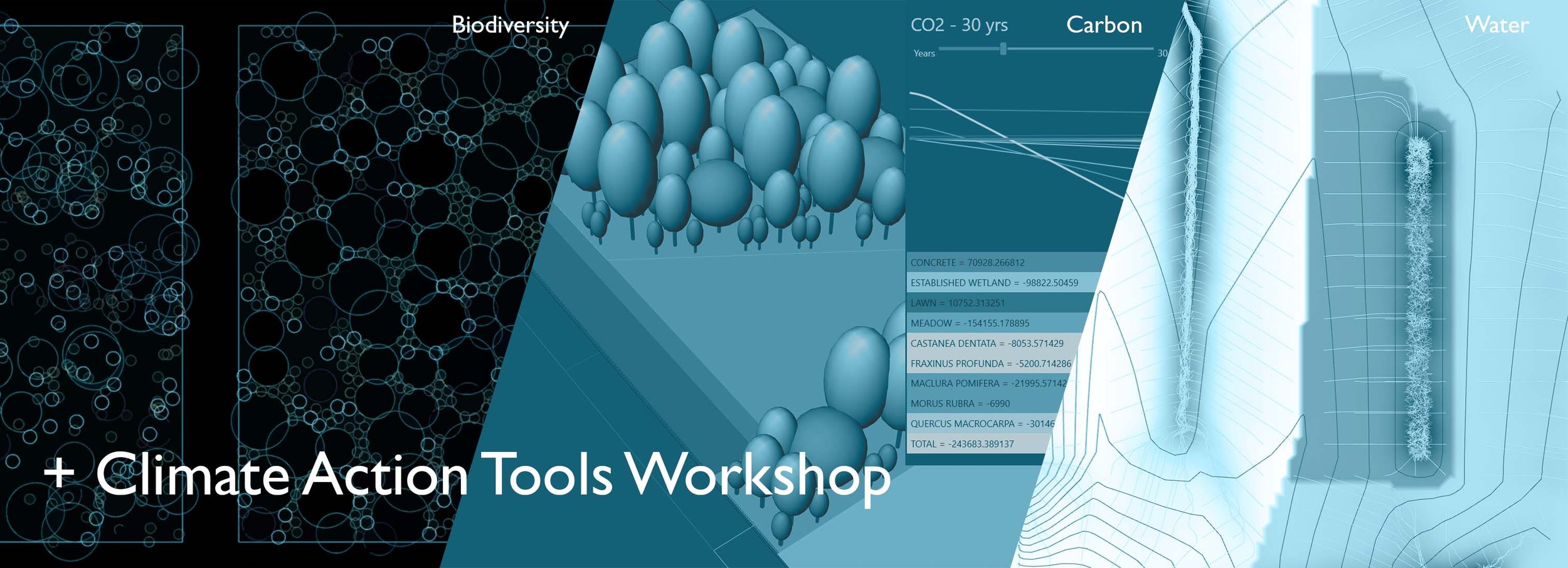Climate Action Tools Workshop
As scientific research continues to unveil the collective impacts of climate change, designers hold a crucial responsibility in shaping a brighter future. Our choices as designers bear significant influence on the environment, from the materials we select to the interventions we make on sites and the layout of our designs. In light of the escalating climate challenges, the LANDAU team recognized the need to empower designers with tools that assist in navigating these complex decisions. Drawing inspiration from the ASLA's Climate Action Plan , we were motivated to develop innovative solutions to aid designers in making sustainable choices. Check out the Climate Action Plan video here.
The Climate Action Tools Workshop will focus on workflows and techniques that allow you to estimate and visualize your project’s response to climate-related issues during the design process. Rhino, Grasshopper, and Land Kit can offer a variety of ways to deal with site planning, deeper analysis, design automation, and much more. Using custom tools and Land Kit workflows, this workshop aims to equip you with specific examples/demos and showcase the possibilities of computational design to become an essential tool when addressing climate change in site design. These sessions will encourage you to follow along and engage in interactive demos and see how the LANDAU team has used computational power to automate design processes and leverage data.
Details
The workshop will span 3 hours with a short break in the middle. For each of the topics covered, there will be a brief overview followed by a demonstration of how Land Kit’s tools can help you achieve these goals!
The first section will talk about Biodiversity, which has been a big focus for us since the beginning. Throughout this workshop, we will be speaking to issues of biodiversity and how our planting decisions, water management decisions, and carbon footprint affect biodiversity in the short and long term. This section will briefly cover ways to think about biodiversity using Plant Kit. We encourage participants to think and engage in conversations about biodiversity during the workshop to continually instill the importance of long-term resiliency in nature.
The second section will focus on Water Management. Evaluating water can be challenging during the design process, but the workflows and tools presented in this section start to show how Land Kit makes this process easier and faster.
The third section will focus on the Carbon Calculator. This tool allows you to estimate the carbon footprint of materials as you design and make changes. Additionally, we will discuss the data used in this calculator and how it is used to estimate your project’s carbon footprint.
Finally, we will briefly touch on two A.I. models — ChatGPT & Midjourney — that can be useful aids to landscape architects for concept generation, sustainability suggestions, code interpretation questions, and plant recommendation and spreadsheet generation.
Participants will be given exclusive access to presentation materials, live instructional demos, interactive work time with direct assistance from our team, and a trial Pro Key (although many of the features we will be sharing are free).
Participants should have Rhino installed using Windows*.
*Land Kit currently works in Windows only, but Parallels can solve this for Mac users.
Instructors
Ben Summay, LANDAU
Chris Landau, LANDAU
Our Learning Objectives
This Climate Action workshop is designed for users with a basic knowledge of Rhino and Grasshopper. All users are welcome to join in to gain more knowledge of how tools are used to calculate and visualize climate related issues in the design process that are crucial to the future of our professions and planet. The primary goals of this workshop are to introduce participants to new approaches to address climate issues through the design process using simple, easy-to-use workflows. Generally, the issues we want to focus on are:
⚫ Carbon
To address climate change and minimize our impact on global warming, it is crucial to recognize the significant influence of human activities, including the construction of landscape architecture projects, play in releasing additional CO2 into the atmosphere. Carbon sequestration serves as a method to prevent such releases and reduce atmospheric CO2 levels. By utilizing CO2 calculators, such as the Land Kit carbon sequestration calculator available with Land Kit 1.2, landscape architects gain valuable insights into the short and long-term effects of their design choices on atmospheric CO2. These calculators, now more accurate and reliable due to the availability of data on carbon capture by various materials and vegetation, play a vital role in the design process. This section focuses on demonstrating the practical usage of the Land Kit carbon sequestration calculator and underscores its importance in landscape architecture design.
💧 Water
In this workshop, landscape architects will delve into the essential role of water management in site design, recognizing its significance guided by policies aimed at safeguarding water resources. Beyond mere compliance, the workshop emphasizes the broader goal of protecting water resources for the benefit of future generations, including humans, animals, and vegetation. Through engaging discussions, we'll explore the fragility of water resources, the challenges posed by overuse and climate change, as seen with the Colorado River. Additionally, we'll examine the interconnectedness of water management, highlighting how mismanagement in one area can impact water resources elsewhere. This session provides practical tools for visualizing water dynamics on sites and equips attendees with valuable analysis tools to enhance water protection and management in a friendly and accessible manner.
🐦 Biodiversity
Biodiversity is a fundamental aspect of nature's long-term resiliency, and each workshop topic addresses its importance in landscape architecture. An ecosystem's survival depends on its variety, which enables it to withstand diseases, environmental conditions, invasive species, etc. Our design choices significantly influence the environment's ability to adapt to Climate Change and Global Warming, making it essential for landscape architects to focus on digital design strategies for diversifying planting palettes.
🦾 A.I. and ChatGPT
Recently, there have been significant discoveries regarding the compelling applications of AI and ChatGPT. As the world and professions continue to explore their potential, we recognize the immense opportunity to harness their capabilities as additional Climate Action Tools. We have valuable insights and intriguing examples that we believe you will find both useful and captivating.
We hope you are eager to learn and to share in your enthusiasm for the future of our planet with us!
And if you are really excited, you can download Land Kit 1.2 today to use alongside a wide range of other tools and plugins available through Grasshopper and Rhino, building your own computational workflows!
Hope to see you soon!!
♥ The Land Kit Team @ LANDAU
Notice: all text in this blog has been generated, modified, and/or edited using ChatGPT.

